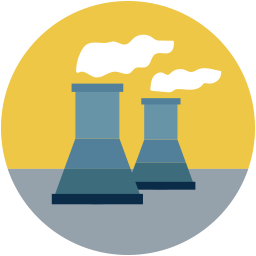 Nuclear power is a way to generate electricity that we use every day. This type of power is created in nuclear power plants all over the world. To understand how this power is made, we first have to take a look at something called the atom.
Nuclear power is a way to generate electricity that we use every day. This type of power is created in nuclear power plants all over the world. To understand how this power is made, we first have to take a look at something called the atom.
Atoms are like building blocks. They are very tiny and can only be seen under a microscope. Everything in the entire universe is made up of Atoms. In fact, there are about 7 billion, billion, billion atoms in a human body!
Atoms are made up of 3 parts:
- Protons
- Electrons
- Neutrons
Protons have a positive electric charge, Electrons have a negative electric charge and Neutrons have no electric charge. In the middle of an Atom, the Protons and Neutrons stick together. This area is called the Nucleus. The Electrons move around the Nucleus.
The force that holds that nucleus together is called, nuclear energy. This energy can be captured and used for nuclear power.
To produce nuclear power, you need uranium atoms. These are found in uranium, a mineral we can dig up from the ground.
When you split a uranium atom into two smaller atoms, it releases heat. This heat is used to produce steam, which turns enormous turbines in a nuclear plant. These turbines power generators that produce electricity. The steam then turns back into water, and can be used over and over again.
Nuclear Power ? Fun & Fast Facts
There are some pretty neat facts about nuclear power. Did you know that in the middle ages, people used uranium to stain glass different shades of yellow or green? Today that same mineral is used as the source of nuclear fuel! There?s plenty more facts where that came from. Check them out below.
- The first plant to generate power for the electricity grid was in 1954 at the USSR Obninsk Nuclear Power Plant.
- The oldest nuclear plants in America have been operating since 1979. That’s only 35 years ago!
- Together, 31 countries in the world have over 430 nuclear plants.
- There are 104 nuclear plants in the United States that supplies about 20% of the country?s electricity.
- Every 18 ? 24 months, a power plant will shut down in order to remove radioactive waste and uranium fuels.
- It costs $6 to $8 billion to build one new reactor for a plant in the United States.
- The sun generates natural energy through Fusion. This is a different type of nuclear reaction.
Red Alert – Nuclear Disasters
Nuclear power plants generate around 14% of the world?s electricity. While this type of energy helps to keep our lights running, nuclear reactors produce radioactive waste. This material is difficult to get rid of safely. Radioactive waste are materials that contain radiation. It causes damage to living things, especially cells and tissue. Because humans are made up of cells and tissue, radioactive waste can be extremely harmful.
This makes running a nuclear power plant a lot of work. If processes are not followed, accidents can happen. These accidents can cause explosions and create a dangerous living situation for the people, animals and plants in the area.
Since the invention of nuclear power, there have been 3 major nuclear disasters. Each accident took 15 to 20 years to clean-up! These messy disasters include,
The Three Mile Island
In 1979, the Three Mile Island Nuclear Generating Station in Dauphin County, Pennsylvania experienced a nuclear meltdown and several minor explosions. A nuclear meltdown happens when the heat created by a nuclear reactor is greater than the heat removed by the cooling system. For Three Mile Island, this was very dangerous because radioactive material escaped into the environment.
Chernobyl
In 1986, there was a nuclear power plant called Chernobyl near the city of Pripyat in the Ukrane. During a systems test, reactor number four experienced a surge in power. When they tried to shut everything down, a rector vessel broke and caused several explosions. The explosions caused radioactive material to enter the air in several cities.
Fukushima Daichi
In 2011, a massive tsunami destroyed large parts of Japan. This caused several equipment failures at the nuclear plant. There were three nuclear meltdowns, which released radioactive chemicals.
These accidents are taken very seriously as they can hurt many people. Sometimes it takes many years to clean up after these major accidents. This is why nuclear plants spend a lot of time and money on safety. They are committed to making sure these types of accidents don?t happen again.
Nuclear Power and the Environment
Radioactive waste is generated as a result of nuclear power. This type of material can be dangerous to the environment for many years. The good news is, these types of materials are monitored closely. This means that the government makes sure that they are handled, transported and disposed of safely.
If a nuclear reactor stops working, it must be retired. This means that the equipment must be safely handled and removed. These buildings must also be thoroughly cleaned before anyone is allowed to enter.


